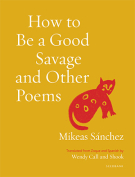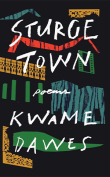Sturge Town: Poems by Kwame Dawes
 Leeds, UK. Peepal Tree. 2023. 149 pages.
Leeds, UK. Peepal Tree. 2023. 149 pages.
Kwame Dawes traces both his literal return to Sturge Town, perhaps the most famous of the free towns established for postemancipation Jamaica beginning in the 1830s, and also a set of themes that are delightfully and powerfully illuminating. These themes include postcolonial life in the Jamaican diaspora (“Wanderer”), the losses of life or passing of time (“After the Biopsy”), and a simple delight in the world as it is (“Ode to a Clothesline”). Two themes get such repeated treatments that they bear special mention: Jamaica’s many musical traditions and Dawes’s connections of visual art to postcolonial identity. These references are sprinkled through the collection. Several ekphrastic poems take up these arts, artists, and the cultural riches of Jamaica. This collection moves as a masterwork in five sections, each named for a quality of light or its actions, finally rising to fullness in the fifth, begun with the epigram “Build me a house of light,” a line taken from Dawes’s own poem “Light Home.” This poem anchors the collection by concluding the fourth section of poems.
“Light Home” is not a poem that seeks to sweep away the atrocities of enslavement or a postcolonial past, but something more elemental, as the image of a “house of light” seeks the “white light that consumes / shadows, that turns this body / of riverbed brown into something / transparent like an ochre— / coloured piece of cotton flapping / in the air.” This imagined house is a new creation in Sturge Town’s literal past and imagined reconstruction. Jamaican free towns were a major achievement of abolitionist Baptists who bought land from slaveholders via London agents so that new freedmen could achieve greater independence from the plantation economy and its injustices and oppressions. This house in Sturge Town that Dawes is building poetically is one of “new light” with the “fragile / membrane separating / us from the chaos” depicted as glass. Images are refracted here by the glass as it is beaded with rain, by the facets of “decanters, / hundreds of them,” and by the faces of familiar faces, “splayed out” as a book upon the poet’s table. This poem seems to strike the materials of the previous four sections into a flame that blazes bright in the fifth section of poems.
That “desk, the scene of such terrible crimes,” launches the fifth part of the collection from topical, archaeological, and cultural explorations of the previous sections into thirteen deeply personal poems—twelve lyrics and a long, six-part exploration titled “Fishing.” This long poem opens into a mythic exploration of the lateness of time between the poet and his love. The images and order of these sections in “Fishing” exude a powerful tone of foreboding and loss. In section one, with the poet and the lady fisher poised over the water as a chasm, Dawes writes: “He is rehearsing his tears and speeches / now, the fear that beneath this placid, familiar surface / is a void so complete, so irrevocably grand in its silences, / it could drown them.” In the poem’s second section, Dawes gives readers the image of a rowboat oared in circles over that void. In the third, a “belief in miracles” seems to include all good things such as sex, hope, and even success in catching fish, for example. The fourth section takes up bodily losses and the efforts humans make after middle age to sustain activities of life while longing for the effortless “world of that old, / glorious orgasm that used to unfold and unfold / for hours and hours and hours.” In the fifth, Dawes takes up an ekphrastic exploration of pre-Raphaelite painter John Everett Millais’s Mariana, inspired in turn by Tennyson’s poem of the same name and taken from Shakespeare’s Measure for Measure.
“Fishing” is my favorite in a collection of poems to read and reread with fresh insights, pleasures, and recognitions each time. In its sixth part, the lady’s love of fishing is described in the details of catch-and-release but also connects to much deeper things, including the metaphor of addiction and the foreshadowing of death. Here the language, pace, and action of the poem reveal the work of a masterful poet. Dawes writes in praise of the fisherwoman: “she can speak to the mute / watery shadows beneath the surface, and there on the water, / where all things move with the sluggish labour of a gorged hawk / rising into the sky, her pulse slows to a drugged slumber. / The nearer she comes to the water, the more / she understands myth.” To experience this poem, much like all the poems in this collection, is to both remember the terrible beauties of the world as well as to see more deeply into its realities by the light of a poet with the powers to illuminate it.
Every poem in this collection seems to be the best of what it tries to be, whether an observation, anthropological recovery, ode, elegy, or even an ars poetica, “The Making of a Poet,” which explores his theme with vulnerability and confession. This verse collection is the twenty-first for Dawes, and the eighty-six poems here demonstrate a full, masterful command of his art.
Scott LaMascus
Oklahoma Christian University

































